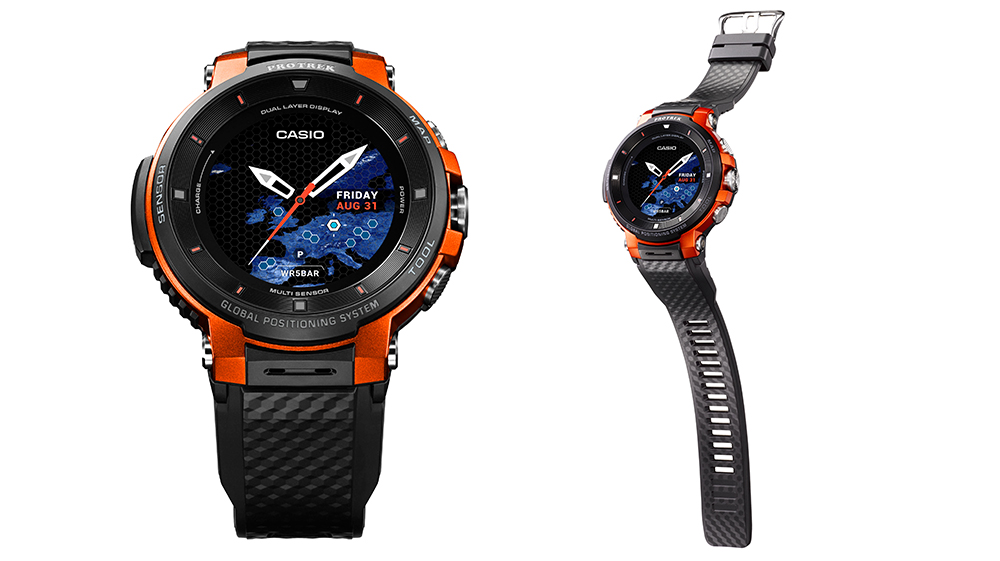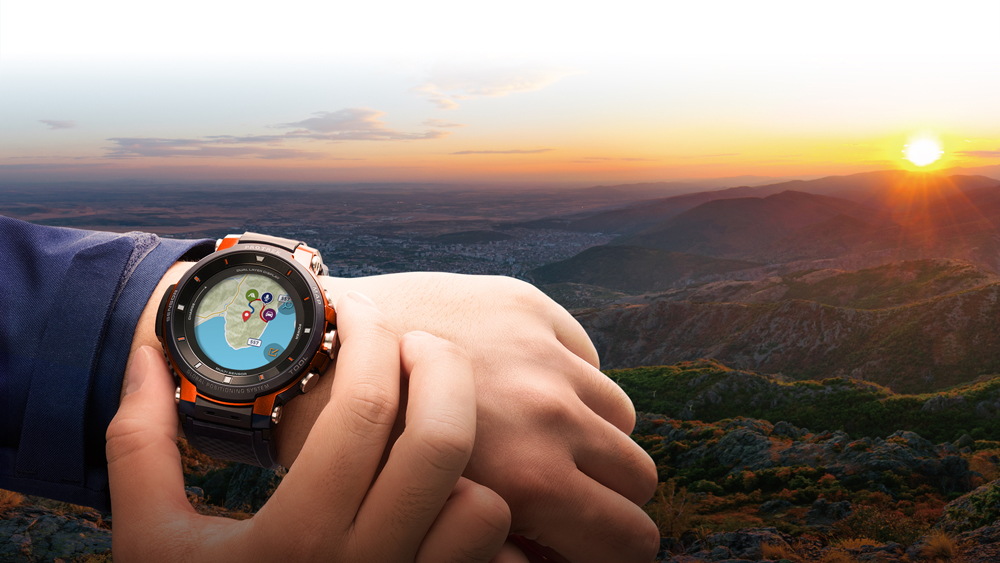You can trust Coach
After a while, reviewing Wear OS smartwatches becomes a bit tedious because what each one can do is limited by the operating system. We’ll come to the limitations of the operating system in due course, but in the meantime it’s worth praising Casio for offering something substantively different.
The Pro-Trek WDS F30 won’t appeal to everyone, and in fact the people it will appeal to probably won’t be too bothered about the smartwatch functions. What they will like is that the device is about as unbreakable as it gets – Casio claims it meets US military standards – and is waterproof too, as well as having colour maps.
The irony is that the maps used by the native software, which Casio has even added a dedicated button for (although you can change that default), aren’t great. Casio’s map tool runs off Google Maps or the open source competitor Mapbox. I am no intrepid explorer but even I know not to go off-grid relying solely on Google Maps. And while Casio’s app can download maps for offline use, it doesn’t attempt to plot routes. I also found it temperamental when the watch wasn’t connected to WiFi. My attempts to load maps via smartphone data in Germany failed multiple times.
Instead, as I found when I lent the device to a more outdoorsy friend who took it trail running and mountain biking around the South Downs, Wear OS offers the ViewRanger app to download. With a subscription, this puts Ordnance Survey 1:25000 maps on your wrist.
That was the killer feature my friend raved about – “brilliant for trail running” – and while you can download ViewRanger on any Wear OS smartwatch, no other device available will be able to take the knocks and bumps you’d expect from someone who needs OS 1:25000 maps. It might be a little too solid for some pursuits, however – my friend’s wrist was left bruised for a week after mountain biking.
There are other unique features that draw on the barometer, compass and altimeter in the watch. For one, it allows dedicated tracking for trekking, fishing, paddling and snow sports. On the more basic fitness trackers I’ve tried, you can track these sports, but there’s little information beyond that derived from GPS and calories burned calculated through movement and heart rate. Trekking on the F30, on the other hand, lets you set a target altitude and will display your total ascent and speed alongside your total descent and speed. Another screen displays a colour map, which can be downloaded before you set off. When tracking snow sports, you can use that map screen to mark the start and stop of each run. Smartly, you can also use a seperate Casio app – essentially an open-ended “If This, Then That” tool – to notify you an hour before sundown, so you get off the slopes in good time and beat the après-ski crush.
Don’t expect to pore over your runs on a big screen afterwards, however. There’s no smartphone app to export these to. The activity stats can be exported, but you’ll need patience and knowledge to work out what they can be exported to and how.
This is the fundamental flaw with the F30. Some good ideas have been poorly executed. Navigating using the touchscreen is fiddly and not intuitive. The three buttons provided are spongy and often unresponsive. Learning what you can do involves trial and error and an awful lot of Googling. The watch frequently disconnects from iPhones. I wouldn’t expect the battery to last longer than a day using it under normal smartwatch conditions, and while certain modes can extend its use in a hiking scenario for two days, you’re restricting the watch’s functions to the very essentials. The charger, too, is poorly designed, disconnecting from the device at the slightest tug and taking more than two hours to recharge the entire battery.
See related
- The Best Fitness Smartwatches
- The Best Fitness Trackers Of 2021
- Garmin Fenix 5 Plus Fitness Tracker Review

It’s a frustrating smartwatch as well. The apps available depend on the unique combination of the watch and phone – and good luck finding out what’s available to you before buying. Rather than ViewRanger, the CityMapper app on my wrist would be incredibly helpful, but frustratingly it’s not available for my set-up.
The smartwatch experience and range of apps, no matter your set-up, far surpasses what’s available from traditional tracking companies like Fitbit and Garmin, but then the fitness tracking capabilities of the F30 are pretty woeful. While this isn’t meant to be the F30’s forte, the trend for smartwatches has been towards offering more fitness tracking – I suspect because people weren’t sold on the usefulness of the smart features. The biggest omission on the F30 is a heart rate monitor, something that’s standard across all but the very cheapest devices now.
You could make the argument that a heart rate monitor would drain the battery too quickly. The hardware does tend to be a battery hog, but then the battery life for day-to-day use on the F30 isn’t noticeably better than on other Wear OS devices I’ve worn – a full charge lasts a day and it needs to be plugged in overnight to make it through another full day. Or you could say the watch is so bulky and heavy (92g) that it would struggle to get a good reading, or even that it’s designed to be worn over jackets. Both fair points, but doubtful considering we already know the next generation of the F30 will have a heart rate monitor.
Perhaps that next watch will manage to combine unique and useful features for adventures in the great outdoors, along with a slick smartwatch experience that will help when you return to civilization, but the F30 seems far enough off now that I wouldn’t hold my breath. If the combination of features suits you, our advice is to take the £450 the F30 costs and buy two watches. Mobvoi, for instance, offers WearOS smartwatches for under £200, leaving you plenty for a rugged adventure watch.
Buy from Casio | £449

Jonathan Shannon was the editor of the Coach website from 2016 to 2024, developing a wide-ranging experience of health and fitness. Jonathan took up running while editing Coach and used the training plans on the site to run a sub-40min 10K, 1hr 28min half marathon and 3hr 6min marathon. He’s an advocate of cycling to work and is Coach’s e-bike reviewer, and not just because he lives up a bit of a hill. He also reviews fitness trackers and other workout gear.

